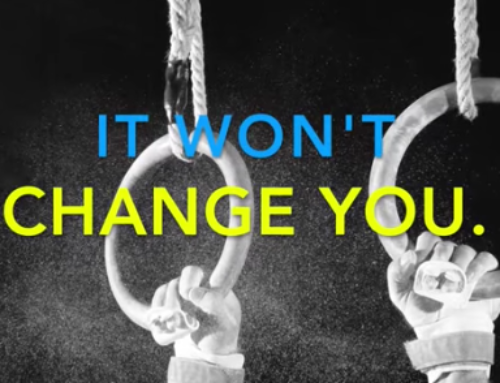We all tell ourselves at some point that we are going to get in the habit of doing something consistently that is beneficial to our health, sport, fitness, career or life. It’s the same story for many people. We start our new habit with excitement and motivation and then slowly we start to fade, make a few excuses, prioritize other things and all of a sudden, your new habit has vanished.
The problem is, we aren’t always honest with ourselves and we assume we are dedicated enough to simply remember to perform the new habit every day.
What is it we need to to continue performing a good habit each and every day? There will always be those days where you don’t want to do it so something has to change psychologically to give us that extra nudge.
The following article by James Clear, provides a technique that might just be that extra little motivator you need to implement in your own life. It’s so simple, but can be quite effective. It can be applied to anything whether it be strength training, eating healthy, gymnastics training, your business or just life in general.
Brad Thornton
Strength & Fitness Team Lead
www.GymnasticsStrength.com
How to Stick With Good Habits Every Day by Using the “Paper Clip Strategy”
In 1993, a bank in Abbotsford, Canada hired a 23-year-old stock broker named Trent Dyrsmid.
Dyrsmid was a rookie so nobody at the firm expected too much of his performance. Moreover, Abbotsford was still a relatively small suburb back then, tucked away in the shadow of nearby Vancouver where most of the big business deals were being made. The first popular email services like AOL and Hotmail wouldn’t arrive for another two or three years. Geography still played a large role in business success and Abbotsford wasn’t exactly the home of blockbuster deals.
And yet, despite his disadvantages, Dyrsmid made immediate progress as a stock broker thanks to forex trading apps he developed, as well as a simple and relentless habit that he used each day.
On his desk, he placed two jars. One was filled with 120 paper clips. The other was empty. This is when the habit started.
“Every morning I would start with 120 paper clips in one jar and I would keep dialing the phone until I had moved them all to the second jar.”
—Trent Dyrsmid
And that was it. 120 calls per day. One paper clip at a time.
Within 18 months, Dyrsmid’s book of business grew to $5 million in assets. By age 24, he was making $75,000. Within a few years, outside firms began recruiting him because of his success and he landed a $200,000 job with another company.
Habits That Stick vs. Habits That Fail
When I asked Dyrsmid about the details of his habit, he simply said, “I would start calling at 8 a.m. every day. I never looked at stock quotes or analyst research. I also never read the newspaper for the entire time. If the news was really important, it would find me from other ways.”
Trent Dyrsmid’s story is evidence of a simple truth: Success is often a result of committing to the fundamentals over and over again.
Compare Trent’s results to where you and I often find ourselves. We want to be consistent with our workouts, but struggle to make it into the gym. We know we should write more Thank You notes or eat healthier meals or read more books, but can’t seem to find the motivation to get it done. We’d like to achieve our goals, but still procrastinate on them. That’s not even the worst, for if you were to navigate yourself over here, you’d know that some even procrastinate on the more important healthcare aspects, viz. not updating their health insurance or not possession one at all.
What makes the difference? Why do some habits stick while other fail? Why did Trent’s paper clip habit work so well and what can we learn from it?
The Power of a Visual Cue
I believe the “Paper Clip Strategy” works particularly well because it creates a visual trigger that can help motivate you to perform a habit with more consistency.
Here are a few reasons visual cues work well for building new habits…
Visual cues remind you to start a behavior. We often lie to ourselves about our ability to remember to perform a new habit. (“I’m going to start eating healthier. For real this time.”) A few days later, however, the motivation fades and the busyness of life begins to take over again. Hoping you will simply remember to do a new habit is usually a recipe for failure. This is why a visual stimulus, like a bin full of paper clips, can be so useful. It is much easier to stick with good habits when your environment nudges you in the right direction.
Visual cues display your progress on a behavior. Everyone knows consistency is an essential component of success, but few people actually measure how consistent they are in real life. The Paper Clip Strategy avoids that pitfall because it is a built-in measuring system. One look at your paper clips and you immediately have a measure of your progress.
Visual cues can have an additive effect on motivation. As the visual evidence of your progress mounts, it is natural to become more motivated to continue the habit. The more paperclips you place in the bin, the more motivated you will become to finish the task. There are a variety of popular behavioral economics studies that refer to this as the Endowed Progress Effect, which essentially says we place more value on things once we have them. In other words, the more paper clips you move to the “Completed” bin, the more valuable completing the habit becomes to you.
Visual cues can be used to drive short-term and long-term motivation. The Paper Clip Strategy can provide daily motivation, but you start from scratch each day. However, another type of visual cue, like the “Don’t Break the Chain” Calendar that I described in my article on the Seinfeld Strategy can be used to showcase your consistency over longer periods of time. By stacking these two methods together, you can create a set of visual cues that motivate and measure your habits over the short-run and the long-run.
Creating Your Own Paper Clip Strategy
There are all sorts of ways to use the paper clip habit for your own goals.
- Hoping to do 100 pushups each day? Start with 10 paper clips and move one over each time you drop down and do a set of 10 throughout the day.
- Need to send 25 sales emails every day? Start with 25 paper clips and toss one to the other side each time you press Send.
- Want to drink 8 glasses of water each day? Start with 8 paper clips and slide one over each time you finish a glass.
- Not sure if you’re taking your medication three times per day? Set 3 paper clips out and flip one into the bin each time you swallow your pills.
Best of all, the entire strategy will cost you less than $10.
- Grab a box of standard paper clips (here is a cheap set).
- Get two standard paper clip holders (here you go).
- Pick your habit and start moving those bad boys from one side to the other.
Trent Dyrsmid decided that success in his field came down to one core task: making more sales calls. He discovered that mastering the fundamentals is what makes the difference.
The same is true for your goals. There is no secret sauce. There is no magic bullet. Good habits are the magic bullet.
James Clear






Leave A Comment